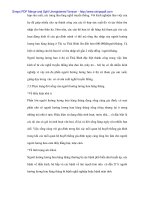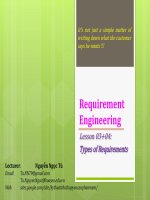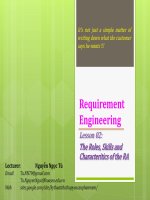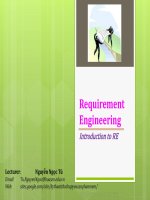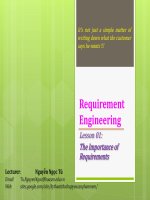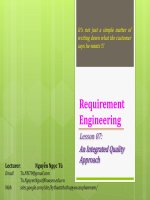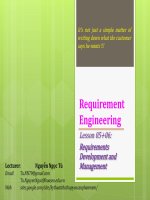slike môn thu thập và phân tích yêu cầu nguyễn ngọc tú chương 2 vai trò và kỹ năng của người phân tích yêu cầu
Bạn đang xem bản rút gọn của tài liệu. Xem và tải ngay bản đầy đủ của tài liệu tại đây (1.59 MB, 46 trang )
Requirement
Engineering
Lesson 02:
The Roles, Skills and
Characteritics of the RA
It’s not just a simple matter of
writing down what the customer
says he wants !!!
Lecturer: Nguyễn Ngọc Tú
Email:
Web: sites.google.com/site/kythuatthuthapyeucauphanmem/
Outline
Suggested Roles of the RA
Skills of the RA
Characteristics of an Effective RA
2012.08
Requirement Engineering
2
[1] chapter 02, 03
Learning Outcomes
Understand the roles and characteristics of RA
2012.08
Requirement Engineering
3
Issues
2012.08
Requirement Engineering
4
[1] chapter 02, p030
2012.08
Requirement Engineering
5
Suggested Roles of the RA
2012.08
Requirement Engineering
6
[1] chapter 02, p001
Roles
2012.08
Requirement Engineering
7
RA Roles
System
Initiation
System
Analysis &
Design
System
Component
Design
System
Inplementation
System
Integration ,
Test &
Evaluation
System
Operations &
Supports
Work collaboratively to identify the real
requirements …
X X A A A A
Work effectively … to manage new and
changed requirements …
X X X X
Be alert to new technologies that may
help.
X X X
reusing artifacts and achieving
repeatability.
X X X X
Assist the project and its customers in
envisioning a growth path …
X X X X X X
Advise the project (and customer) of
methods, techniques, and automated
tools …
X X X
Use metrics to measure, track, and
control …
B X X X X X
Be able to facilitate discussions and to
mediate conflicts.
X X X X X X
Study the domain of the area … X X X
A—Continue to identify real requirements for subsequent releases and revisions, maintaining configuration control.
B—System initiation or “project or task startup” is a confusing time. The experienced RA will be able to lend assistance. For
example, the RA should provide a briefing to the project team that includes thetopics noted in Table 5.4.
Roles: 1. collaboratively
Work collaboratively with customers, users, and system
architects and designers
to identify the real
requirements for a planned system or software
development effort to define the problem that needs to
be solved.
2012.08
Requirement Engineering
8
Roles: 1. collaboratively
Activities involved in performing this work
Identifying the stated needs of customers and users. This
involves reviewing things previously written about the
proposed system, inter -viewing customers and users,
studying relevant legislation, and so forth.
Studying the business objectives for the proposed effort.
Collaborating with customers and users in a joint or
cooperative environment to analyze the stated
requirements, evolve better requirements, and prioritize
them (see the suggested techniques that follow).
2012.08
Requirement Engineering
9
Roles: 1. collaboratively
Activities involved in performing this work
Involving system architects in requirements development.
Iterating the draft or proposed requirements will result in
a candidate architecture with better requirements and a
more robust architecture. For example, systems need to be
able to accommodate changing business needs. The
architecture should be designed and developed
accordingly, or else the delivered system soon will be
outdated.
Utilizing an industry strength automated requirements
tool to support this work.
2012.08
Requirement Engineering
10
Roles: 2. effectively
Work effectively with customers and users to manage
new and changed requirements so that the project stays
under control. Install a mechanism to control changes.
It’s The next most serious problem .
Critical requirements
have an impact on cost, schedule, or the development
effort if changed
Non-critical requirements
such as a derived requirement that further defines the
system being built, but serves to clarify a higher-level
requirement and does not affect cost, schedule, or
functionality
2012.08
Requirement Engineering
11
All stakeholders should welcome a “no-impact” requirement that further clarifies the system.
2012.08
Requirement Engineering
12
Roles: 2. effectively
must be explained to customers, users, and developers
the partnership commitment to project success is
maintained.
must be trained not to accept unauthorized
requirements changes.
should be a joint team
2012.08
Requirement Engineering
13
Roles: 2. effectively – actions
Partnering with your customer, evolve ways to deal with
change.
The world is changing while we’re developing the system.
Ensure that your contract provides for additional time
and budgeting for all changes.
2012.08
Requirement Engineering
14
Roles: 2. effectively – actions
Roles: 3. Be alert to new technologies
Be alert to new technologies that may help
advising our customers concerning evolving technology
would be well advised to spend additional time and effort
learning about new technologies
Decision Analysis Resolution (DAR) CMMi
Keep the customer involved in these activities
2012.08
Requirement Engineering
15
Roles: 4. reuse
2 meanings
to take object X that was done by Y and use it directly
in another project
to tailor a developed work product
2012.08
Requirement Engineering
16
Roles: 5. growth path
helping customers to envision and evolve a series of
releases or versions of products
is particularly appropriate in the situation in which
requirements are not well understood at the outset or
the requirements are changing rapidly
2012.08
Requirement Engineering
17
Roles: 6. to best support
is an important role
methods and techniques vary in their applicability and
effectiveness
The development work is challenging enough
should adapt to the tools that the customer already has
in place
don’t pretend …
2012.08
Requirement Engineering
18
Roles: 7. Use metrics to measure
The industry literature concerning metrics is vast
20% : it provides helpful counsel
The things that are measured and tracked and that
management pays attention to are the ones that
improve.
This involves quantitative management (QM) of cost,
schedule, quality, and process metrics and baselines in
support of specific business objectives
2012.08
Requirement Engineering
19
Roles: 8. facilitate & mediate
people skills (soft skills)
negotiating skills, team building, communications,
relationships, and leading
Two heads are better than one
we get even better ideas and approaches!
2012.08
Requirement Engineering
20
Roles: 8. facilitate & mediate
2012.08
Requirement Engineering
21
Requirements
Verification
Requirements
Analysis
Requirements
Specification
Requirements Management
Requirements
Elicitation
Roles: 8. facilitate & mediate
2012.08
Requirement Engineering
22
Roles: 9. Study the domain
Be able to grasp, abstract, and express ideas quickly in
the users’ language.
“If not” : he risks limiting his role to that of an order
taker
2012.08
Requirement Engineering
23
Main points
ensuring that experienced RAs are assigned to each
project
providing appropriate training for Ras
assigning experienced RAs to mentor new employees,
junior RAs, and interns
having an organizational requirements working group
to share expertise and provide a resource to the
organization
2012.08
Requirement Engineering
24
Skills of the RA
2012.08
Requirement Engineering
25
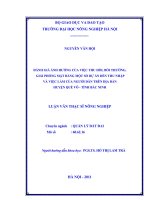
![[Luận văn]thực trạng việc làm, thu nhập và đời sống của người lao động nữ vùng nam dương tỉnh hoà bình](https://media.store123doc.com/images/document/13/gu/in/medium_mnEJA1jAIa.jpg)
